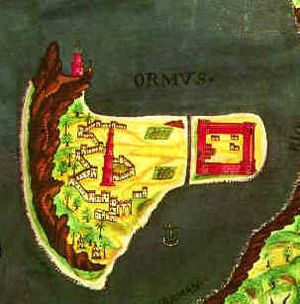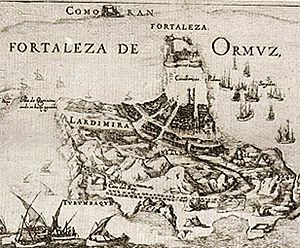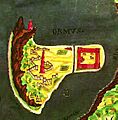Safavid–Portuguese conflicts facts for kids
Quick facts for kids Persian–Portuguese War |
|||||||
|---|---|---|---|---|---|---|---|
 Persian portrait of a Portuguese nobleman (16th century) |
|||||||
|
|||||||
| Belligerents | |||||||

The Persian–Portuguese War was a long conflict that lasted from 1507 to 1622. It was fought between the Portuguese Empire and its ally, the Kingdom of Ormus, against Safavid Persia (modern-day Iran). The Kingdom of England also helped Persia.
During this time, Portugal controlled the important island of Ormuz for over 100 years. They also ruled Bahrain for more than 80 years. Portugal captured other places like Qeshm and Bandar Abbas. The war ended when the Persian ruler, Abbas the Great, took over Portuguese Bahrain. This led to more fighting in the Persian Gulf.
In September 1507, the Portuguese explorer Afonso de Albuquerque landed on Hormuz Island. Portugal controlled Ormuz from 1515 to 1622. The Kingdom of Ormus, which was like a partner to Portugal, helped invade Bahrain in 1521. This ended the rule of the Jabrid family in that area.
The Portuguese tried to take control of Basra several times but failed. Later, the local ruler of Basra asked Portugal for help against the Safavid ruler Abbas I. From then on, the Portuguese stayed in Basra as traders with a trading post and as an allied army.
Portugal Takes Over Ormuz
The capture of Ormuz was part of a big plan by the King of Portugal, Manuel I. In 1505, he wanted to stop Muslim trade in the Indian Ocean. His plan was to capture key cities:
- Aden, to block trade through Alexandria.
- Ormuz, to block trade through Beirut.
- Malacca, to control trade with China.
A fleet of ships was sent to capture a fort on Socotra island. This fort was important for controlling the entrance to the Red Sea. This was done in 1507. Most of the fleet then went to India, but a few ships stayed with Albuquerque.
Albuquerque decided to go against his orders and capture Ormuz island. He made the local king agree to be loyal to the King of Portugal. He also got permission to build a fort using local workers. He started building the fort on October 27, 1507. However, he couldn't keep control of it because of local resistance. Some of his Portuguese captains also left and went to India.
Portugal Captures Bahrain
As a partner of Portugal, the Kingdom of Ormus helped invade Bahrain in 1521. This ended the rule of the Jabrid family in Bahrain. The Jabrid ruler, Muqrin ibn Zamil, was supposed to pay tribute to Ormus. But he refused, which led to the invasion. The Portuguese conqueror, António Correia, led the attack.
Most of the fighting in Bahrain was done by Portuguese soldiers. The Ormusi admiral, Reis Xarafo, mostly watched. The Portuguese ruled Bahrain through governors from Ormus. However, the Ormusi governors were not liked by Bahrain's Shia population. The Shia people faced unfair treatment because of their religion, which caused rebellions.
In one case, rebels even crucified an Ormusi governor. Portuguese rule in Bahrain ended in 1602. This happened after an Ormusi governor, who was related to the Ormusi king, started executing members of important Bahraini families.
Persia Fights Back
In 1602, Abbas I ordered the Persian army to act. The army, led by Imam-Quli Khan, successfully forced the Portuguese out of Bahrain.
In 1612, the Portuguese Empire took the city of Gamrūn. They changed its name to Comorão. Almost two years later, in 1615, Abbās the Great took Comorão back after a naval battle with the Portuguese. He renamed it Bandar-e ‘Abbās, which means "Port of ‘Abbās".
In 1622, Abbas, with the help of four English ships, took Hormuz back from the Portuguese. At this time, the Portuguese Empire was one of the largest and most powerful empires in the world. Losing Hormuz had many effects. For example, Portugal also lost the Mombasa war. The Imam of Muscat, supported by the Persian king, captured Fort Jesus in Mombasa.
After the capture of Portugal's important fort at Fort Jesus in Mombasa Island (now in Kenya) in 1698, the Portuguese Empire started to decline. They lost most of their land in East Africa to the British. The British later recognized the Persian Empire as the only ruler of the entire Persian Gulf. This was written in a treaty in 1809.
Images for kids







